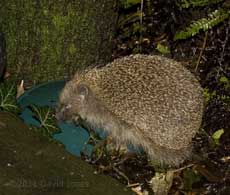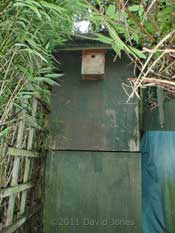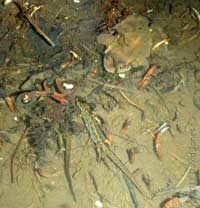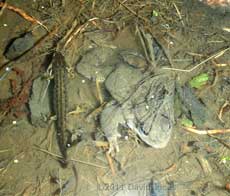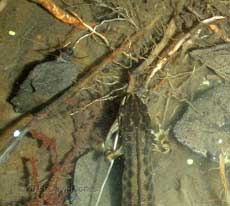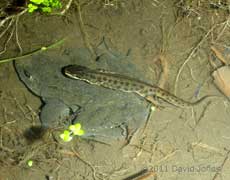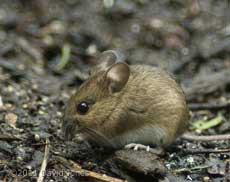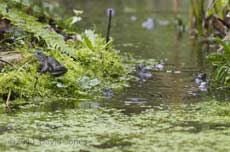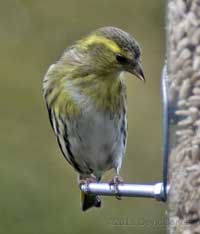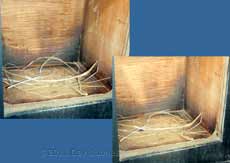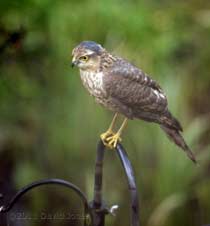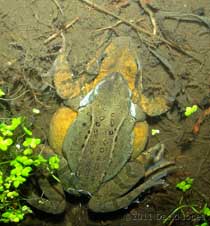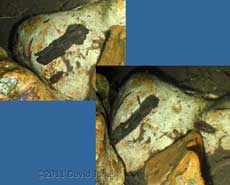Go to the last entry on this page .....Go to previous entry15 February - Another one of those thoroughly miserable, wet days, and with the temperature no higher than 6C I have seen no sign of daytime frog activity in the pond. Tonight at 9.25pm the skies are clearing but the temperature is still above 5C, and in the pond I can see (but not hear) eleven frogs and a single newt. At the same time there was a first sighting for the year in the area in front of the veranda - a Hedgehog which was nibbling at the remains of an Eccles Cake that had been put on a ground feeder tray this morning. By the time I grabbed my camera it had moved on and was having a drink when I took just this single picture before leaving it in peace.
16 February - It seems to be a case of sunshine and showers on alternate days at the moment. After yesterday's gloom today has been bright and sunny. Mind you, even though the temperature approached 10C in the early afternoon the pond remained a quiet place.
On my first visit of the year I need to take in a length of bamboo and
wave it about to gather up the webs that seem to fill the top few feet
of the structure. Unsurprisingly there is a distinct lack of insect
life in the box, although the white spots that cover every horizontal
surface below the webs suggest that the spiders do not starve during
the winter!
Most of them are now distributed to other sheltered places in the garden. For those of you not familiar with this nest box, I built it years ago to allow me to observe and photograph nesting Blue Tits, although in recent years the Great Tits took over. The birds' entrance is some 8ft from the ground while my entrance is a door at ground level behind which are a few steps up to a platform and narrow bench seat. The image below shows the arrangement immediately behind the nest box. This area is normally kept dark and hidden behind a black curtain. 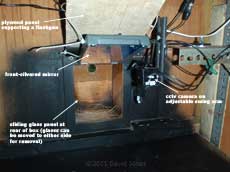 In addition the the cctv camera that 'looks' through the glass there
is also a second camera in the top of the box itself, along with some
LED lighting (controlled via a timer) and a microphone.
In addition the the cctv camera that 'looks' through the glass there
is also a second camera in the top of the box itself, along with some
LED lighting (controlled via a timer) and a microphone.The mirror allows me to 'look down' onto the nest, especially useful once the nest is built and has a deep nest cup. The flashgun hidden above the plywood points into the nest box through an opening fitted with a diffuser. It remains in position throughout the nesting season and can be switched on and off remotely. 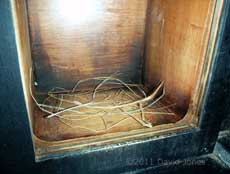 As I'm not in a position to switch on the cameras yet, I have put some dried grass into the nest box and taken a photograph of it. I shall check this every couple of days to see if it has been moved. By the end of the week I hope to complete the cleaning and sort out the electrical arrangements before I prepare to switch on one of the cameras to test the links to my house. Once that job is done I'll need to turn my attention to the Swift boxes where I need to install additional infra-red LEDs. 19 February - After a couple of dry days we opened the curtains on a wet start this morning, although by early afternoon it has become just gloomily overcast with just a touch of dampness in the air, and with the temperature achieving no higher than 6C. The day before yesterday the temperature rose to over 11C and in the late evening I spotted thirteen frogs and a couple of newts (one with a fresh water cockle firmly gripping a digit on a hind leg - a common sight in the pond every Spring!). 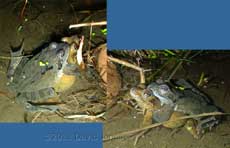 Yesterday was slightly colder, with the temperature only getting up to around 9C, and a check of the pond soon after 10pm turned up just seven frogs, although this included two pairs. In this case the female looked quite plump, but it is still early days for actual mating and there was no sign of spawn this morning. And as of 1pm the straw in the nest box remained undisturbed since being added three days ago. I have not had time to sort out the electrics in the box, a task that will now have to wait until after the weekend.
Only two of those frogs had their heads out of the water, the other four being on the bottom, looking rather squashed by the pressure of just a couple of inches of water above them. In this picture you can see not just one of them, but also two newts - a spotted male in full view and a female to its left, mostly hidden by debris.
And another frog and male newt in close proximity.
In that second photograph you may just make out a caddis fly larva in the top-left corner. You can see it rather better in this cropped version of the same photograph. This time the larva is partly emerged from its cut leaf 'house'.
Finally, the newt in the previous picture decided to head back into deeper water, swimming over another of the submerged frogs.
20 February - Another heavily overcast day. It remained dry, although it was colder than recently, with the temperature not getting above 5C. The nearest we got to a highlight of the day was the appearance of a mouse that was either brave or desperate enough to dash out frequently to feed in the area below the bird feeders, even with up to five Wood Pigeons coming and going. We see the occasional mouse here throughout the year,
although rarely during the day. This was the first
sighting of one in 2011. With today's colder conditions it's not surprising that I saw no signs of frog activity in the pond during daylight hours. And tonight at 10pm with the temperature still around 5C I could only see four frogs and one newt, with just one frog at the water's surface. However, the Hedgehog is out and about and seemed to be digging(?) furiously around the base of a fern, perhaps after a worm.
21 February - On another glum day we have had some light rain/drizzle, and the temperature rose to 7C for a while during the afternoon. The pond has remained quiet and to a great extent so have the bird feeders with few visits by Goldfinches and just one sighting of a Siskin male. At least the mouse was back this afternoon. While the dim conditions didn't allow for faster camera shutter speeds at least this time I was able to watch it for longer as it wasn't disturbed by the birds.
This behaviour fits in with it being a Wood Mouse, a species that is happy to eat insects and other small invertebrates during the winter months.
I am hoping to do some tidying up of the website this year, so from time to time you may see changes taking place, such as the rationalizing of the buttons at the left of the page. This is the first step in the process and the buttons are likely to change again once I have delved a little deeper into my various books and bits of software.
23 February - The dull, damp weather continues today, with the temperature just under 9C at 11am. Last night at around 10pm I counted 28 frogs, with 18 in the big pond and the remainder in the small one. Yesterday there was once again the sound of croaking by a single frog,
While I can see them from the house, They dive under the water and mud as soon as I approach so it wasn't possible to do a daytime count.
Tonight at 10pm the situation wasn't much easier, but I was able to see 18 frogs and 2 newts in the big pond and a further 6 frogs and just a single newt in the small pond. This morning brought another first for the year, and a moment of frustration (no camera at hand) when a male Sparrowhawk arrived, his rufous breast feathers really standing out against the dullness. I was upstairs when the Sparrows' chirping in the Hawthorn turned to a cacophony of panic calls as the hawk landed on top of the tree. Having failed to surprise the sparrows he tried the usual trick of flying to another tree (at the other end of my neighbour's garden), waiting a short time before swooping to approach the Hawthorn from a low angle. When this failed to dislodge any of the sparrows he landed on the top of the Hawthorn just briefly before flying away, talons empty. A minute later the now very quiet sparrows started to reappear at the top of the tree, and to my surprise a Magpie also emerged. In the past I've seen Magpies apparently following the Sparrowhawk, but this one seems to have been sheltering with the Sparrows! Anyway, once the Magpie flew off a group of Sparrows also left. As they flew over the conifers at the bottom of the garden I caught sight of the Sparrowhawk as it launched itself from a tree a number of gardens away - obviously he had not completely given up...
24 February - A bright day with some very welcome sunshine, raising the temperature to 14C around noon, although soon after dusk it was back down to single figures. The frogs were very active all morning and when I walked down the garden at around 10.30am I estimate that besides those that dived on my approach there were still between 20-30 frogs at the surface for a few moments. In the later afternoon, as pond became shaded there was a rapid drop in activity, and when I went to my shed at just before 5pm I saw no frogs.
The Goldfinches made most of their visits during the morning, with up to six at the feeders at any one time. There was no sign of a Sparrowhawk today.
The Wood Mouse was about again, and in the early
afternoon Sheila and I were able to stand on the veranda and
watch it from no more than 6ft away as it continued its
search for food.
Just a note of caution - towards the left of the second image there is a small dark object - a live woodlouse. I don't think that this is responsible for the change, but I shall be waiting for video confirmation of this. As is usual for this box, it isn't being used as a roost prior to the nesting season and I only expect occasional daytime visits in February/early March. Having said that, both Great Tits spend a lot of time in the garden and today I heard the male proclaiming his territory very loudly from our Birch tree.
26 February - A mixed day, starting quite bright, with occasional slight rain and a high of 10C around 2pm. Then, dark clouds rolled in, and the temperature dropped by at least a couple of degrees during a heavy downpour along with gusty winds - the skies remaining overcast since then.
Unfortunately, the windows were peppered with a dense coating of water droplets which acted as a random diffuser filter in front of the camera lens. As a result the pictures needed rather more processing (probably too much?) than I would normally expect to carry out. The final large image includes the original frame that it was extracted from.
Again, as before it flew down the garden, paused before returning to the Hawthorn itself, finally flying off with nothing to show for its attack. Down in the ponds the frog numbers continue to increase slowly. Last night I spotted 23 frogs in the big pond with a further 10 in the small pond. I have not attempted a daytime count today but watching from the house I can confirm quite a bit of activity in the big pond - no spawn yet. The forecast is for lower temperatures as we head into March. It will be interesting to see how the frogs react. There have been no visits to the Great Tit box over the last couple of days. However, today I set up my time-lapse recorder to record continuously the images from the two cameras and by tonight I hope to have my radio microphone operating as well. This often picks up the calls of the birds before /after any visits they make to the box. I also need to move a large P. phalangioides spider that has been constructing its web in front of the rear camera, and clean the glass while I'm there.
28 February - A month of rather disappointing weather has come to a miserably dull, damp conclusion, with light rain falling for most of the day, and temperatures not getting above 6C - at 8pm it remains overcast, with the temperature now below 4C. There's no news to report from the Great Tit nest box, other than that the microphone is now operating alongside the two cameras. In addition to the weather conditions, other commitments have also kept me from the garden for most of the day, but when I did check the pond there were just a couple of frogs to be seen. During the late morning I left a thermometer in the water for a while, registering 5C as opposed to the 6C of the air above it. Last night when I checked at 10pm I counted seventeen frogs visible in the two ponds, although only six were at the surface - as three pairs. The rest were resting on the bottom, with several pairs amongst their number.
Looking at these raised a question - I know that frogs can breathe through their skin when underwater, but how do they control their buoyancy? Is it a case of simply swimming to the surface and breathing enough air into their lungs? How much air can they retain in their lungs when they head for the bottom again, and not be bothered with positive buoyancy.
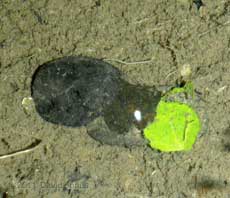
While the rest of these larvae were 'dressed' in the usual drab discs of decaying leaves, this individual stood out from the crowd thanks to that bright green leaf disc.
I believe that the larvae that cut
the leaf discs are likely to be a species called
Glyphotaelius pellucidus. The adults appear in
April-June and after mating their eggs are laid in a jelly
coated egg sac on a leaf that overhangs water. Once hatched
the larvae will then fall into the water where they develop,
remaining there right through the following winter. This
presents me with a couple of challenges, starting with can I
photograph the adults, and any egg cases that they may
produce here.
In this case the pieces of vegetation appear to be predominantly rectangular, forming a much more tubular case.
One bit of flower news - today I spotted what may be the first White Dead-nettle blossom of the year.
Click on images to see larger version
|
2011 Garden Diary Index.... .... . ...Last Month...............March |
